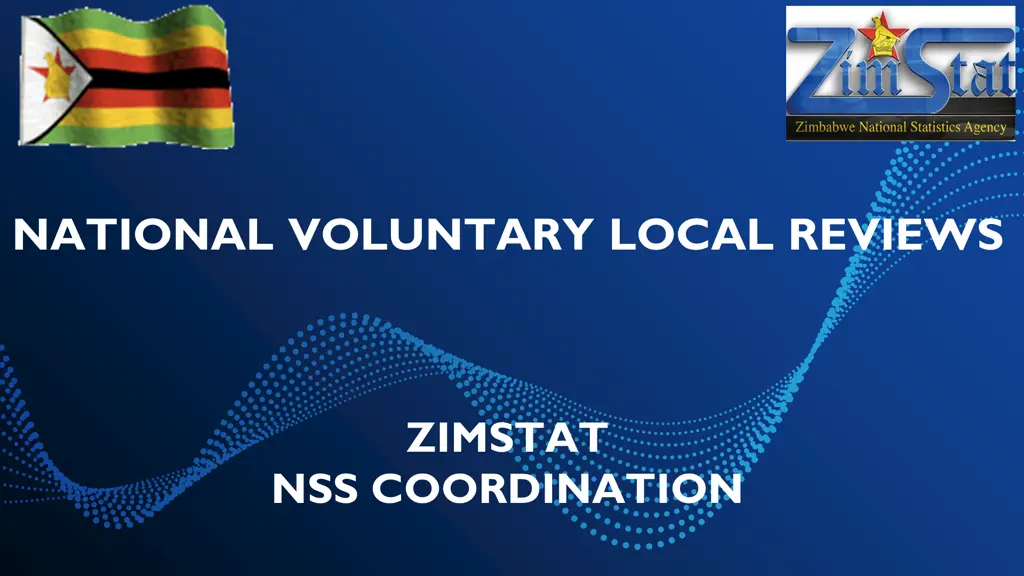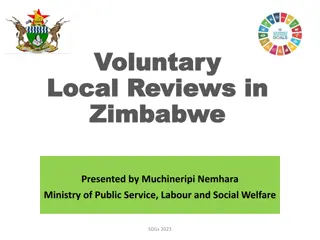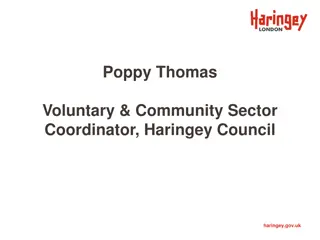National Voluntary Local Reviews
Status of data for SDG monitoring in Zimbabwe, the challenges faced in data production, and recommendations for mitigating data gaps.
- national reviews
- voluntary reviews
- local reviews
- data gaps
- challenges
- recommendations
- SDG indicators
- Zimbabwe
Download Presentation

Please find below an Image/Link to download the presentation.
The content on the website is provided AS IS for your information and personal use only. It may not be sold, licensed, or shared on other websites without obtaining consent from the author. Download presentation by click this link. If you encounter any issues during the download, it is possible that the publisher has removed the file from their server.
E N D
Presentation Transcript
NATIONAL VOLUNTARY LOCAL REVIEWS ZIMSTAT NSS COORDINATION
Outline of Presentation Status of SDG Indicators Data Gaps and Challenges faced in Overcoming the Gaps Recommendations for Mitigation of Data Gaps 2
Introduction National The (ZIMSTAT), in terms of the Census and Statistics Act of 2007, provides official statistics for monitoring of national and global development plans. Zimbabwe Statistical Agency This presentation provides a highlight on the status of data for SDG monitoring and challenges encountered during its production. 3
During the 2022 period ZIMSTAT carried out a Population and Housing Census which produced 30 SDG indicators directly from the data. The introduction of a Quarterly Labour Force Survey has also seen an improvement in up to date data on employment and unemployment. 5
Updated GDP figures covering the period 2017 to 2021 were released. The Agency is now producing quarterly GDP figures, a move that will improve periodicity and provide timely data for the Devolution Agenda, (2019 -2022). 6
Planned ZDHS which focuses on health indicators and whose results should be available by June 2024 Updating of Vital and Migration Statistics in progress Zimbabwe Budgeting Survey (formerly PICES) to be undertaken during the 4thqtr 2023. 7
Overall, about 63,2% of priorirised SDG indicators can be monitored using available data leaving a gap of 36,8%. This is after incorporating data collected from the 2022 Population and Housing Census & Quarterly Labourforce. 8
Social Goals-5 Economic Goals 3 Environmental Goals - 8 Peace - 1 Prioritized Goals: Goal 2: Goal 3: Goal 4: Goal 5. Goal 6: Goal 7: Goal 8: Goal 9: Goal 13: Goal 17: 63.2% Quantitative Qualitative Administrative 86 14 63
Data Gaps and Challenges Faced in Overcoming the Gaps
Data produced by ZIMSTAT for SDG monitoring is derived from its censuses and surveys whilst administrative data. other institutions produce However, these censuses and surveys are periodical and carried out after a fixed period of time, e.g. 3, 5 and 10 years. This results in the proliferation of data gaps in between surveys unless such data are available from other sources. 11
However, the situation with regards to data availability shows that there still exist data gaps. It should be noted that gaps exist where data is entirely not available anywhere (eg. Goal 14) ZIMSTAT is carrying out a data gap analysis to establish which indicators are mostly affected. It is only through such an exercise that a plan can be developed to find ways of mitigating these gaps 12
Challenges in Overcoming Gaps Missing Data - where data is not collected anywhere Non-existence of a robust sharing arrangement between ZIMSTAT and data suppliers Failure to conduct dedicated surveys due to funding issues No capacity to explore other sources of data , e.g citizen generated data, big data 13
Recommendations for Mitigation of Data Gaps
National Strategy for Development of Statistics (NSDS III), 2021 - 2025 The production of a National Strategy for Development of Statistics (NSDS III), is expected to increase data available for monitoring Developments collaboration with NSS stakeholders. Plans through improved The strategy was designed in line with aspirations of NDS1, Agenda 2030 and Agenda 2063 and is expected to mitigate the challenges of data gaps collaborative approach in data production. through adoption of a 15
A lot of data that can be harnessed for statistical purposes are scattered across most MDAs and with better coordination of the National Statistical System, data flow to ZIMSTAT will be greatly improved. 16
Use of Non Traditional Sources of Data The Agency, in line with global trends in statistical production is considering the use of non-traditional sources of data such as citizen generated data, big data and proxies to complement already existing sources. However, going this route may take some time to implement due to lack of capacity and the need to learn from best practice. 17
Data Sharing Agreements MDAs and other institutions within the NSS generate huge amounts of data kept as administrative records. Such data can be harnessed for statistical purposes and help reduce existing data gaps. ZIMSTAT Developed a Data Sharing Agreement to allow the Agency easy access agreement should allow ZIMSTAT to receive data in an agreed format at agreed timelines to secondary data. The 18
Partnerships in Data Collection The Agency partnerships with organisations in their areas of interest. can boost data availability through Such partnerships provide data to complement already existing or where data is entirely not available 19
The Agency responsible must fulfil coordination function effectively Closing Data Gaps Adopt common principles, standards and policy frameworks to ensure data comparability and integrate data from different sources, as well as a supportive environment for collaboration the capacity to Supply Vs. Demand Production must occur within a framework of demand Consider the use of ,non-traditional sources, proxies where data are not readily available A ensures long-term production of vital data. funding model that robust Partnerships in Data Production Data Sharing Agreements
I THANK YOU 21























